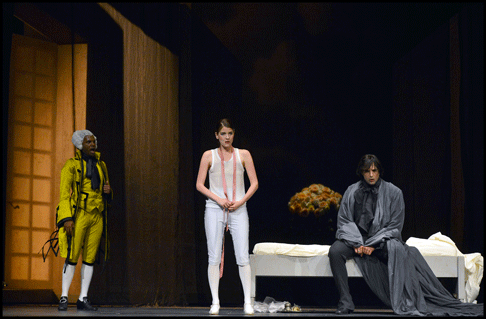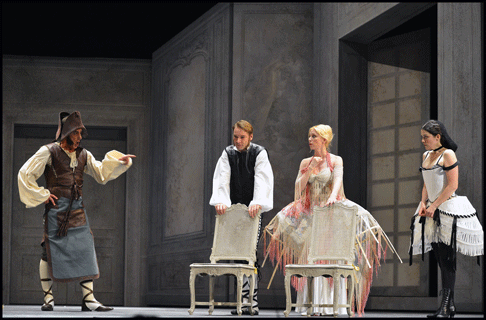Haute couture designer Jean Paul Gaultier created costumes for Mozart’s masterpiece in this new production of Le Nozze di Figaro at the OpÈra National de Montpellier with set design and stage direction by Jean-Paul Scarpita. The most theatrical among haute couture stars Gaultier is uniquely suited to Mozart comedy, sharing with the venerated composer both sharp wit and a preoccupation and fascination for women.
Gaultier had a particular fascination for his grandmother’s underclothes, structural corsets above all, and this preoccupation with structure permeates his oeuvre (currently on exposition at the De Young Museum in San Francisco, through August 19). In Montpellier he literally exposed the understructure of late 18th century couture in visible linear sculptures that resonated wittily with Mozartian musical structures.
Like all haute couture that of Gaultier is elegant and luxurious. In Montpellier (France’s most elegant city) Mozart too became haute couture of rarefied elegance and luxury. The reduced Orchestra National de Montpellier was in splendid form responding to Austrian conductor Sascha Goetzel’s delicate and obsessive shaping of the multiple instrumental voices that sang out in flights of studied splendor. Mo. Goetzel evoked a multitude of unusual colors and musical shapes by exploiting the sharper sounds we associate with early music rendered by the virtuoso forces of this exceptionally fine modern French orchestra.
Now let us talk about true perfection (and the suspicion that you had to fit the clothes to get the role). Czech baritone Adam Plachetka was the epitome of the libidinous Almaviva, in a costume masterpiece that resonated with the darkness of a Don Juan figure. Mr. Plachetka towered as the male, thirty-ish libido in full force, his voice with a sharp, maybe sadistic edge, and power, know-how and vulnerability. Svelte blond Italian soprano Erkia Grimaldi countered with a precociously full lyric thirty-ish Rosina and an astounding vocal technique (the reprise of Dove sono sung in a sleepy pianissimo). When not the sensuous woman in a form-fitting white early Hollywood gown lying on the floor or petting in a corner with Cherubino she donned a towering white wig-like construction to become the Countess.
Cherubino, young Israeli soprano Rachel Frenkel entered in white underclothes eschewing all trouser affectation. She was soon dressed by Rosina and Susanna to be Cupid himself as he remained for the rest of the opera. This Cherubino sung in an unusually lyric fashion was an ephemeral blue presence. Bartolo, Italian basso Antonio Abete, and Marcellina, svelte, not-at-all tall French mezzo Virginie Pochon were dressed in brilliant crimsons and were colorful rather than buffo objects, as was the brilliant yellow Basilio of French tenor LoÓc FÈlix.
 LoÔc FÈlix as Basilio, Rachel Frenkel as Cherubino and Adam Plachetka as Count Almaviva
LoÔc FÈlix as Basilio, Rachel Frenkel as Cherubino and Adam Plachetka as Count Almaviva
Both Figaro and Susanna were light on their feet, German baritone Konstantin Wolff effecting a few very graceful full body falls (not to ignore a spectacular body roll over the fourth act bench by Almavia himself). Mr. Wolff was in black leather pants and white shirt with criss crossing details that hinted Harlequin. An exquisite actor and fine singer he created a Figaro of genuine, even moving innocence, assuming finally the fetal position next to Marcellina during her fourth act aria. QuÈbÈcoise soprano HÈlËne Guilmette, Susanna, carried an exposed traverse bustle under construction on her hips for most of the opera. The opera’s catalyst, its constructive and destructive forces she delivered her Deh, vieni alla fenestra with consummate innocence, its words emerging with such vocal naturalness that it seemed nearly spoken.
Designer and stage director Scarpita offered a vaguely detailed architectural space of neutral color in which the vividly costumed actors assumed high relief. There were very few props — an abstracted Susanna/Figaro bed subsequently also served as the chair for the first act trio (though the only idea of a bed in the Countess’ boudoir was the Countess lying on the floor). There was no window for Cherubino’s escape (he ran off stage right), and there was no shrubbery to hide behind in the fourth act. This minimalism was strikingly elegant, and carried into Mr. Scarpita’s story telling by his omission of most gestural detail, streamlining the action into fleet, sometimes abstractly narrative lines.
There were some real problems in the performance on June 26. Conductor Goetzel concentrated his attention on his instrumental voices, the stage voices left to fend for themselves. But sometimes these brilliant young artists missed the dramatic and musical confidence to be on their own, and, well, maybe opera does need an opera conductor after all. At the worst moments, and there were many, the pit and stage seemed absolutely unconnected (at best, in the fourth act, Mozart was more magical than ever).
 Peter Longauer as Antonio, Konstantin Wolff as Figaro, Erika Grimaldi as Countess Almaviva and HÈlËne Guilmette as Susanna
Peter Longauer as Antonio, Konstantin Wolff as Figaro, Erika Grimaldi as Countess Almaviva and HÈlËne Guilmette as Susanna
The brilliance of the costume design and the refinement of the staging seemed to overwhelm the simple humanity of the repertoire’s most succinctly human opera.
It could be that everyone’s game was a bit off that evening. The performance was postponed for 30 minutes so that the chorus, orchestra and stage hands could make the audience aware of their dissatisfaction with Jean-Paul Scarpita as general director of the OpÈra National de Montpellier. Among the complaints was that Mr. Scarpita had banished the chorus to the pit for this production because he did not want “fat cows” (des vaches grasses they said he said) on the stage, replacing them with the lithe bodies of supernumeraries who presumably fit more suitably into haute couture.
Such artistic considerations would have been more commendable had Mr. Scarpita used a corps de ballet (even better bodies than his supernumeraries) and a choreographer for his servants and peasants. These scenes were regretful, clumsy moments.
There are two more performances as part of the Montpellier Radio France Festival, July 14 and 15. It is quite possible that stars may align and forces may converge to achieve the perfection we imagined on June 26.
Michael Milenski
image=http://www.operatoday.com/_MG10323a.gif
image_description=Adam Plachetka as Count Almaviva and HÈlËne Guilmette as Susanna [Photo courtesy of OpÈra Orchestra National Montpellier]
product=yes
product_title=W. A. Mozart: The Marriage of Figaro
product_by=Almaviva: Adam Plachetka; Rosina: Erika Grimaldi; Susanna: HÈlËne Guilmette; Figaro: Konstantin Wolff; Cherubino: Rachel Frenkel; Bartolo: Antonio Abete; Marcellina: Virginie Pochon; Don Basilio: LoÓc FÈlix; Don Curzio: Thomas Curzio; Barbarina: Omo Bello; Antonio: Peter Longauer. Chorus and Orchestra of the OpÈra Orchestra National Montpellier. Conductor: Sascha Goetzel; Stage Director and Set Designer: Jean-Paul Scarpita; costumes: Jean Paul Gaultrier; Lighting: Georg Veit. OpÈra ComÈdie, 26 June 2012.
product_id=Above: Adam Plachetka as Count Almaviva and HÈlËne Guilmette as Susanna Photos courtesy of OpÈra Orchestra National Montpellier.